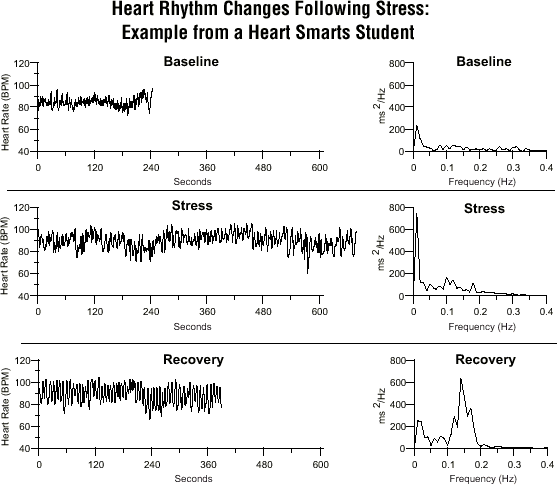The Impact of an Emotional Self-Management
Skills Course on Psychosocial
Functioning & Autonomic Recovery to Stress in
Middle School Children
Palm Springs Middle School, Dade County, Florida.
Rollin McCraty, PhD, Mike Atkinson, Dana Tomasino,
BA,
Jeff Goelitz, MEd and Harvey N. Mayrovitz, MD.
Integrative Physiological and Behavioral Science. 1999; 34 (4): 246-248.
Key findings: Key findings: Middle
school students enrolled in a HeartMath self-management
skills course exhibited significant improvements in
areas including stress and management, risky behavior,
work management and focus, and relationships with
teachers, family and peers. Students who used the
Freeze-Frame technique to recover from acute emotional
stress were able to positively modulate theirphysiologicalstressresponses,
increasing heart rhythm coherence, physiological entrainment
and parasympathetic activity.
Summary: This joint research study between the Institute of HeartMath and the Miami Heart Research Institute examined the impact of a HeartMath program on psychosocial functioning and physiological responses to stress in students at Palm Springs Middle School (located in Hialeah, Florida, near Miami). An initial phase of the study measured psychological and behavioral changes in 32 at-risk seventh grade students (age range 12-13 years, mean age 12.2 years) who participated in a HeartMath emotional self-management skills program. School counselors had observed that many of these students were distracted at school by various social pressures and negative emotions such as anxiety and depression, which diverted their attention from focused academic learning, even among students with high ability. A preliminary analysis reinforced the need for the school to implement the self-management training, indicating that a number of the students were at risk for anxiety, school dropout, risky behavior problems and negative peer influence, and many had difficult home lives. The HeartMath program comprised a total of 16 hours of training, delivered over the course of two weeks. Pre and post evaluations of children's achievement aptitude, interpersonal skills and mental attitudes were conducted using the Achievement Inventory Measure (AIM). This test requires students to report on how they deal with issues at school, at home with friends, and on internal self-talk.
Results indicated significant improvements following the HeartMath program in 17 of the 19 areas of psychosocial functioning measured by the inventory, including anger management, teacher comfort, self-reliance, work management and focus, perceptions of family support/satisfaction and decreases in risky behavior. After the training, the students scored well above the average range on many of scales on which they had previously scored below the norm. Complete results are shown in Figure 38.
In summary, the data indicated that after learning the HeartMath techniques, students felt more motivated at school, were more focused in their school work and better able to organize and manage their time, both at school and at home. Their leadership and communication skills improved, and harmful behavior problems decreased. They felt more supported by their families and friends, more comfortable with their teachers and showed increased compassion with their peers. The children also felt more comfortable with themselves, were more assertive and independent in their decision making, more resistant to the demands of peer pressure, and better able to manage their stress, anger and negative internal self-talk. In essence, the children showed increased satisfaction and control over their lives while with friends, at school and around their families. Notably, these significant improvements occurred within a short period of time in an at-risk population with below-average levels of psychosocial functioning. Further, a follow- up analysis indicated that many of these changes were sustained over the following six months.



Figure 38. Psychological and behavioral
improvements in at-risk seventh grade students after
learning HeartMath tools and techniques. The Achievement
Inventory Measurement test was administered one week
before and one week after the completion of the emotional
self-management skills program. Scales measured by
the test are divided into three general categories:
Achievement Aptitude, Interpersonal Skills and Mental
Attitudes. Results are reported as percentile rankings
based on norms established from analysis of an extensive
age-and gender-matched student population. Following
the program, students demonstrated significant gains
in nearly all measures. A 6-month follow-up analysis
indicated that many of these improvements were sustained
over time (data not shown). * p < .05, ** p <
.01, *** p < .001. (Significance based on pre/post
raw scores.)
After observing the improvements in their children's attitudes, behavior and performance, many of the students' parents also attended HeartMath trainings in order to have a common language and set of tools.
In addition, 15 of this study's seventh graders volunteered
to participate in a crossage mentoring program at
a community elementary school, where they tutored
55 at-risk second and third graders in the HeartMath
techniques.
In a second phase of the study, the HeartMath program
was expanded into the middle school curriculum as
a full-year elective course called HeartSmarts. The
course was designed to reinforce resiliency skills
and positive citizenship among students, while counteracting
the negative effects of mental and emotional stress
on learning. The course reinforced the application
of the techniques through a variety of fun, experiential
games and activities, including participation in a
cross-age mentoring program with elementary school
students. The students' training also included a heart
rhythm education component, in which students were
given the opportunity to see changes in their heart
rhythm patterns in real time when they used the Freeze-Frame
and Heart Lock-In techniques. The course was provided
to 60 children in grades sixth through eighth (age
range 12-14 years, mean age 13.2 years) in two separate
classes. From this group, 30 children were randomly
selected to form the experimental group. An additional
30 children, randomly selected from classmates not
enrolled in the HeartSmarts course, comprised the
control group.

Figure 39. The heart rate tachograms and HRV power spectra of one trained student show a representative example of the changes in heart rhythm patterns and autonomic balance that occurred in the HeartSmarts group throughout the stressful interview. As this student used the Freeze-Frame technique during the recovery interval, note the shift to a near sine wave-like pattern in the HRV trace, and the corresponding marked increase in the LF region of the power spectrum (large peak). This pattern reflects a state of increased heart rhythm coherence. This type of favorable physiological shift was not observed in control group participants.
In this phase of the study, the impact of the Freeze-Frame
self-management intervention on children's autonomic
responses to acute emotional stress was assessed by
measuring heart rate variability parameters immediately
prior to, during and following a structured interview
designed to elicit emotional re-sponses to real-life
stressful issues. HRV analysis was performed to assess
stress-induced changes in autonomic activity and balance,
and to determine any significant changes upon application
of the Freeze-Frame technique immediately following
the stressful interview.
Results showed that both trained and untrained students exhibited significantly enhanced cardiovascular reactivity and autonomic activation during the stress-ful interview. However, HeartSmarts students who used the Freeze-Frame technique immediately after the interview showed significant differences in ANS function and balance in relation to the control group, who were asked to recover by relaxing in any way they normally would. As compared to the control group, trained students demonstrated significantly increased HRV and more rhythmic, sine wave-like heart rhythm patterns during recovery (See Figure 39). This favorable response pattern reflects increased parasympathetic activity and heart rhythm coherence, associated with increased heart-brain synchronization and entrainment of the body's major oscillatory systems.
In summary, results suggest that by applying the Freeze-Frame technique in a stressful situation, middle school children were effectively able to positively modulate their physiological responses to emotional stress in real time. As increased physiological coherence is associated with improved cognitive performance, emotional balance, mental clarity and health outcomes, it is proposed that these types of physiological shifts could also serve to promote the sustained psychological, behavioral and performance-related improvements observed in students who applied the emotional management techniques. This study clearly demonstrates that practical emotional self-management skills can be effectively taught to middle school-aged children, and further illustrates the generalizability of the Freeze-Frame technique to diverse age groups and conditions. Results support the concept that learning emotional competence skills in childhood may help establish healthier psychological and physiological response patterns, which can benefit learning, behavior and long-term health.

Letter written by a seventh grade student enrolled
in the HeartMath
program at Palm Springs Middle School to Jeff Goelitz,
trainer for
HeartMath's educational programs.
